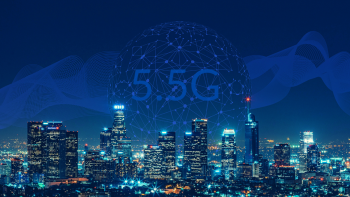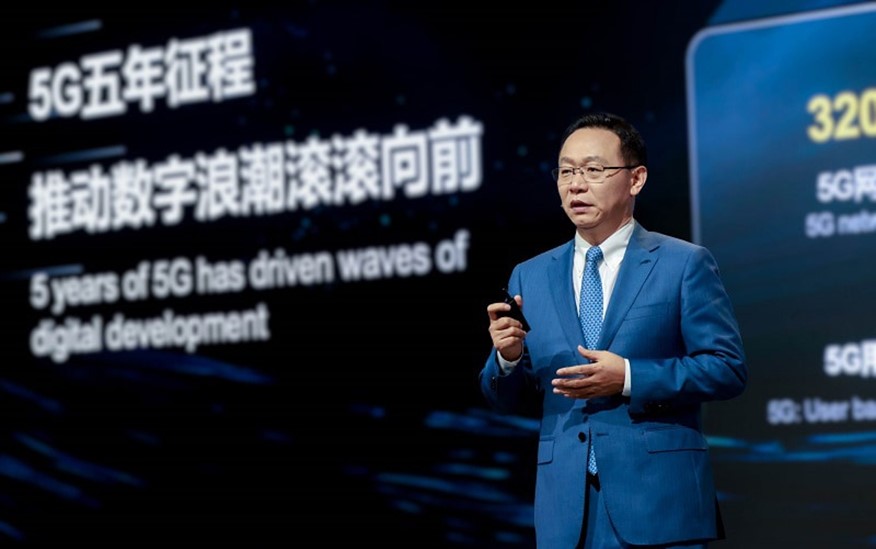
David Wang, Huawei’s Executive Director of the Board and Chairman of the ICT Infrastructure Managing Board, spoke at MWC Shanghai 2024 on “Advancing 5.5G and Shaping the Mobile AI Era.”
sIn the keynote, Wang said, “2024 marks the first year of commercial 5.5G and the integration of AI into a wider variety of devices. The mobile AI (Artificial Intelligence) era is on the horizon, where intelligent services will be pervasive. So, we must work hard on both Networks for AI and AI for Networks to accelerate 5.5G development and maximise value of the mobile AI era.”

David Wang delivers a keynote speech at MWC Shanghai 2024.
The full content of David Wang’s speech can be found below:
Advancing 5.5G and Shaping the Mobile AI Era
Over the past five years, commercial 5G has achieved remarkable success and made an unprecedented impact on the global mobile industry. 5G has extended the breadth of global services, delivered higher speeds for better experience, and deepened digital transformation around the world.
5G is continuing to develop even faster today. The first standards release for 5G-Advanced—3GPP Release-18—was officially frozen on June 28, 2024 in Shanghai. More than 60 carriers and partners have also announced commercial 5.5G deployment. Commercial 5.5G terminals are now ready to face the world and 5.5G will continue to drive waves of digital development.
Over time, milestones in the development of wireless communications technologies have given rise to several great eras. In 1991, the emergence of GSM networks and widespread adoption of mobile phones kicked off the mobile voice era and made calling at any time and anywhere, a reality. In 2007, 3G and smartphones spearheaded the mobile Internet era, and made global information readily accessible.
2024 marks the first year of commercial 5.5G and the integration of AI into a wider variety of devices. The mobile AI era is on the horizon, where intelligent services will be pervasive. We will see three seismic changes in the mobile AI era.
First, human-computer interaction will shift from being touch-based to multimodal. This means the ways we interact with computers will extend to natural language, gestures, and emotions, delivering on-demand, 24/7 experience.
Second, content generation will be revolutionised. Previously, people acquired information mainly through search engines. In the future, such information will be generated by AI. Information production will be no longer about prefabrication, but about customisation, making comprehensive and tailored real-time services available.
Third, mobile devices will also undergo a transformation, as mobile devices transition from smartphones to AI terminal assistants and embodied AI. This means mobile devices will become portals to seamless AI.
These huge changes in the mobile AI era will revitalise society and create tremendous opportunities for the mobile industry.
Thanks to graphical interaction, mobile data traffic growth outpaced Moore’s Law for the past 10 years. Specifically, DoU has grown by 125 times over these 10 years. This means DoU has doubled every 17 months. In the upcoming mobile AI era, as new forms of interaction sweep the world, generative content will become a primary method of information acquisition, in the place of retrieval, increasing interaction efficiency by 100 times.
AIGC will also facilitate the generation of content in different formats, including 3D and spatial video, increasing content volume by 100 times. As a large number of mini models that are built in devices start to collaborate with foundation models on the cloud in real time, the number of interaction objects will also grow by 100 times. All these will drive a new wave of explosive data growth, outpacing Moore’s Law once again.
In the field of Internet of Vehicles (IoV), intelligent connected vehicles will reshape driving, making the activity safer, easier, and more enjoyable. Intelligent cockpits will create brand new driving experiences and gigabit network experience will better support vehicle-mounted smart assistants, video streaming on multiple screens, extended reality (XR) applications, and other requirements. This will make vehicles a mobile third space suited for both leisure and work.
At the same time, intelligent driving will disrupt traditional driving systems. Every month, 100 GB of driving data will be uploaded to train the intelligent driving system, making models, perception, and responses more accurate in dynamic driving environments. In addition, millisecond-level V2X will provide reliable and stable driving strategies in real time. All in all, intelligent connected vehicles will unleash the value of connectivity, not just for experiences, but also for time and safety. Connectivity will shine through intelligent connected vehicles.
The boundaries of the Internet of Everything (IoE) will be also greatly expanded in the mobile AI era. As machines are more able to think and move around like humans, network connections will expand from humans to silicon-based digital humans, which will create 10 billion new connected AI assistants and workers.
For individuals, everyone will have an AI assistant in the future that runs on their smartphones, glasses, and AI devices. AI assistants will move beyond just being tools and become our companions, responding to requirements in all scenarios like work, play, and learning in real time.
In industry, every smart factory will have an AI brain, enabling AI workers to deeply integrate into production activities. AI workers will be capable of self-learning and making accurate responses, improving the quality and efficiency of the end-to-end process from production and maintenance to quality inspection and logistics.
There will be so many new connected AI assistants and workers, tens of billions, that they will eventually outnumber the connections of people and spearhead a new era of human-machine integration.
The mobile AI era will present tremendous new opportunities. And so, against this backdrop, the whole industry needs to work closely together and make the most of what this era has to offer. 5.5G is a key pillar of the mobile AI era, so Huawei will continue to accelerate its development and work with carriers and industry partners to create new commercial value. This will require joint efforts in the following two areas.
The first is Networks for AI, which means using networks to fuel the development of AI in order to lay a solid foundation for the mobile AI era. There will be a wide array of services in the future, which will, in turn, raise higher requirements for network capabilities such as large uplink and downlink bandwidths and low latencies.
To meet the growing demand for the Internet of People (IoP) and IoV, we will need to accelerate the evolution of all frequency bands to support 5.5G experience, fully unleash the value of each frequency band, and build a foundation for a superior network experience.
The second area that requires joint effort is AI for Networks, which means using AI to empower networks and enable network productivity surges on all fronts. To fully embrace AI, improving network O&M efficiency is imperative.
Our Telecom Foundation Model, for instance, accelerates the evolution of networks to L4 Autonomous Networks (ANs) and provides two types of applications: role-based copilots and scenario-specific agents. Copilots improve the productivity of different roles by providing Q&As related to professional knowledge and assisted O&M. Agents, on the other hand, can understand user intent and orchestrate tasks to automatically resolve issues in complex scenarios.
In the mobile AI era, a solid network foundation will provide fertile ground for developing innovative applications and business models. We will need these upgraded business models and boost the value of connectivity in all scenarios. In the consumer market, there will be a continuous stream of new intelligent applications, and consumer demand for experience will continue growing across multiple dimensions.
This will drive a shift for carriers from monetizing data traffic to monetising multiple experience dimensions. In industrial scenarios, intelligent services will continue seeing wider adoption and create new monetization opportunities for carriers to expand from just providing connectivity to providing novel services combined with connectivity.
I believe, over the next decade, we will fully embrace mobile AI. The intelligent world is fast approaching, and 5.5G will serve as a cornerstone of future development. As always, Huawei will remain committed to working with all industry players to seize the tremendous opportunities presented by the mobile AI era and build a fully connected, intelligent world.
Huawei Is at the Forefront of the Mobile AI Era
MWC Shanghai 2024 was held from 26 to 28 June in Shanghai, China. During the event, Huawei showcased its latest products and solutions at stands E10 and E50 in Hall N1 of the Shanghai New International Expo Centre (SNIEC).
2024 will mark the first year of commercial 5.5G, and F5.5G gigabit optical network deployment has already begun. Synergies across networks, cloud, and intelligence are set to give rise to pervasive intelligent applications and increasingly diverse user experiences.
Together with global operators, industry professionals, and opinion leaders, Huawei will dive into exciting topics at this year’s MWC Shanghai, like how to amplify 5G’s success in the 5.5G era and how to tap into the potential of operator revenue growth to bring us even faster to the intelligent world.
For more information, please visit: https://carrier.huawei.com/en/events/mwcs2024.
 (0)
(0) (0)
(0)Archive
- October 2024(44)
- September 2024(94)
- August 2024(100)
- July 2024(99)
- June 2024(126)
- May 2024(155)
- April 2024(123)
- March 2024(112)
- February 2024(109)
- January 2024(95)
- December 2023(56)
- November 2023(86)
- October 2023(97)
- September 2023(89)
- August 2023(101)
- July 2023(104)
- June 2023(113)
- May 2023(103)
- April 2023(93)
- March 2023(129)
- February 2023(77)
- January 2023(91)
- December 2022(90)
- November 2022(125)
- October 2022(117)
- September 2022(137)
- August 2022(119)
- July 2022(99)
- June 2022(128)
- May 2022(112)
- April 2022(108)
- March 2022(121)
- February 2022(93)
- January 2022(110)
- December 2021(92)
- November 2021(107)
- October 2021(101)
- September 2021(81)
- August 2021(74)
- July 2021(78)
- June 2021(92)
- May 2021(67)
- April 2021(79)
- March 2021(79)
- February 2021(58)
- January 2021(55)
- December 2020(56)
- November 2020(59)
- October 2020(78)
- September 2020(72)
- August 2020(64)
- July 2020(71)
- June 2020(74)
- May 2020(50)
- April 2020(71)
- March 2020(71)
- February 2020(58)
- January 2020(62)
- December 2019(57)
- November 2019(64)
- October 2019(25)
- September 2019(24)
- August 2019(14)
- July 2019(23)
- June 2019(54)
- May 2019(82)
- April 2019(76)
- March 2019(71)
- February 2019(67)
- January 2019(75)
- December 2018(44)
- November 2018(47)
- October 2018(74)
- September 2018(54)
- August 2018(61)
- July 2018(72)
- June 2018(62)
- May 2018(62)
- April 2018(73)
- March 2018(76)
- February 2018(8)
- January 2018(7)
- December 2017(6)
- November 2017(8)
- October 2017(3)
- September 2017(4)
- August 2017(4)
- July 2017(2)
- June 2017(5)
- May 2017(6)
- April 2017(11)
- March 2017(8)
- February 2017(16)
- January 2017(10)
- December 2016(12)
- November 2016(20)
- October 2016(7)
- September 2016(102)
- August 2016(168)
- July 2016(141)
- June 2016(149)
- May 2016(117)
- April 2016(59)
- March 2016(85)
- February 2016(153)
- December 2015(150)
